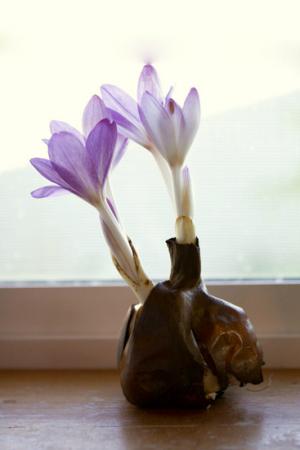Colchicums bloom with six-inch-tall, goblet-shaped blossoms
Your eyes may be a window to your soul, but a window is actually an eye to the wind. The word window comes to us from Old Norse, and literally means a “wind eye.”
Whether window shopping or taking a window of opportunity, or even the dreaded “next window, please,” windows abound in our lives.
But what if a window is all the garden you have? Like Jason and the Argonauts finding a golden fleece, there is a bulb that will bloom on a windowsill without being planted or watered. Just set it on the sill and let it grow and bloom.
These magical bulbs are the fall-flowering colchicums, named after the ancient nation of Colchis in modern-day Georgia. In Greek mythology, Colchis is the land of the golden fleece.
Colchicums bloom with six-inch-tall, goblet-shaped blossoms from September to November, depending on the variety. They send up broad, strappy leaves in early spring which die down by summer. Then in autumn they send up naked ladies, which are flowers with no leaves at all.
Because they bloom in the fall and look like large crocus, colchicums are often called “fall-blooming crocus,” but technically they are a different species. For quick reference, colchicums have six stamens, while crocuses have three stamens. The corms or bulbs of colchicums are the size of daffodil bulbs, much larger than those of crocus.
If planted in the ground, your fall-flowering colchicums will naturalize and spread slowly. The mother bulb, actually a corm, will sprout small cormlets around the edge of the bulb. These will grow to full size and flower in a year or two. Carefully break off these baby corms from the mother bulb and replant immediately. Dig them up during summer when the colchicums are dormant.
There are several named varieties of colchicum. Waterlily has double, soft-pink to light-purple pompom flowers that do indeed look like water lilies.
The pre-1926 heirloom called the Giant is not only one of the tallest colchicums, but also the most free-flowering. Its tall single blooms are pink, fading to white at the base.
Colchicum autumnale Alboplenum blooms with clusters of fully double, creamy white chalice-shaped blooms up to six inches tall. Best of all, it can have has many as eight flowers per bulb.
If you decide to plant your colchicums outdoors, choose a spot with well-drained soil in light shade. All colchicums are hardy in USDA Zones 4-9, but in the South they prefer denser shade. For best effect, plant them in large clusters in soil with a pH of 5.5-6.5 . Plant the bulbs three to four inches deep with the pointy side up.
Place them under trees or plant them directly in the lawn. Even though they bloom in autumn, they grow leaves in spring that die down by summer. For best results, never let the soil completely dry out even if it means watering in the summer. Apply a slow-release, all-purpose bulb fertilizer when the leaves sprout up in the spring. Colchicums are not usually attacked by insects and tend to be disease free.
A warning: all parts of the colchicum are poisonous to pets, so keep these away from pets and children.
So stop window shopping and get some colchicums for your windowsills. It will soothe you as you ponder your own window to the soul while, perhaps quarantined, you fight with your computer over – what else – Windows.





















































